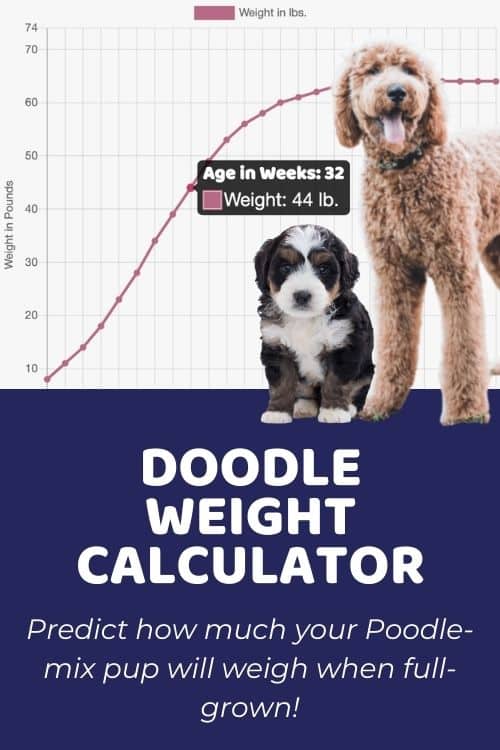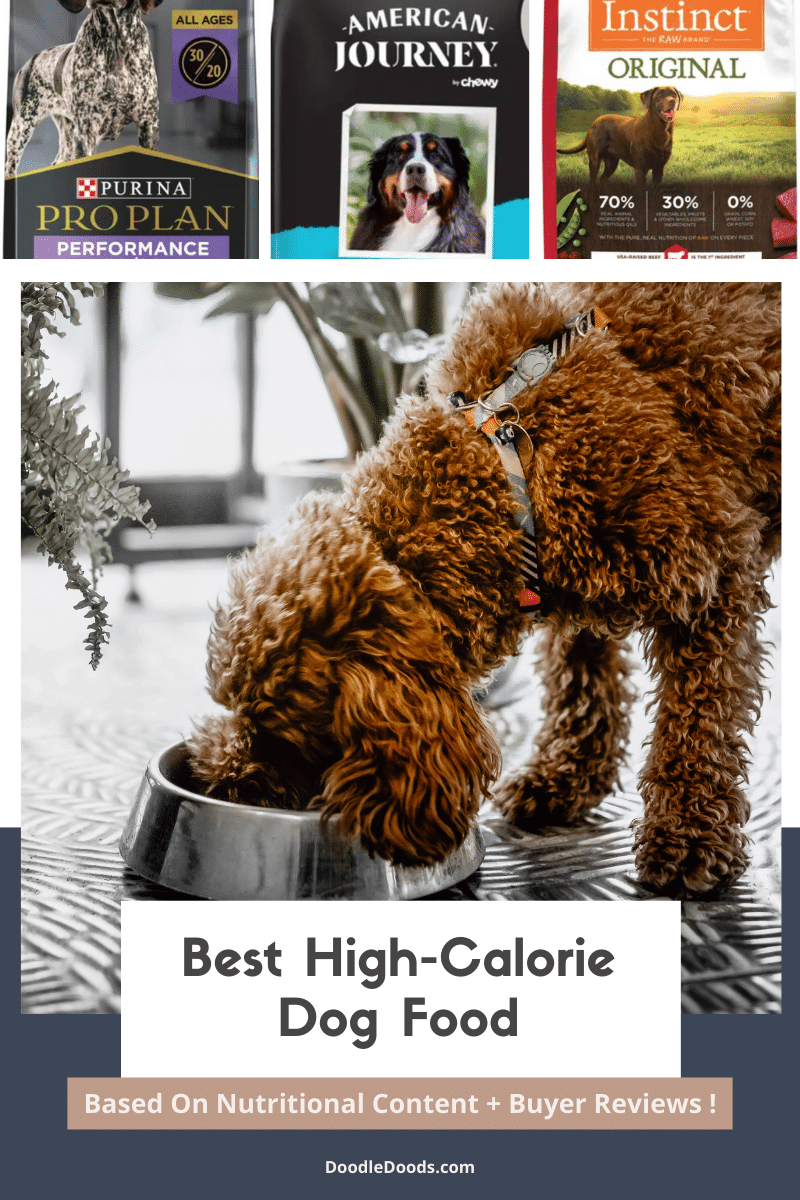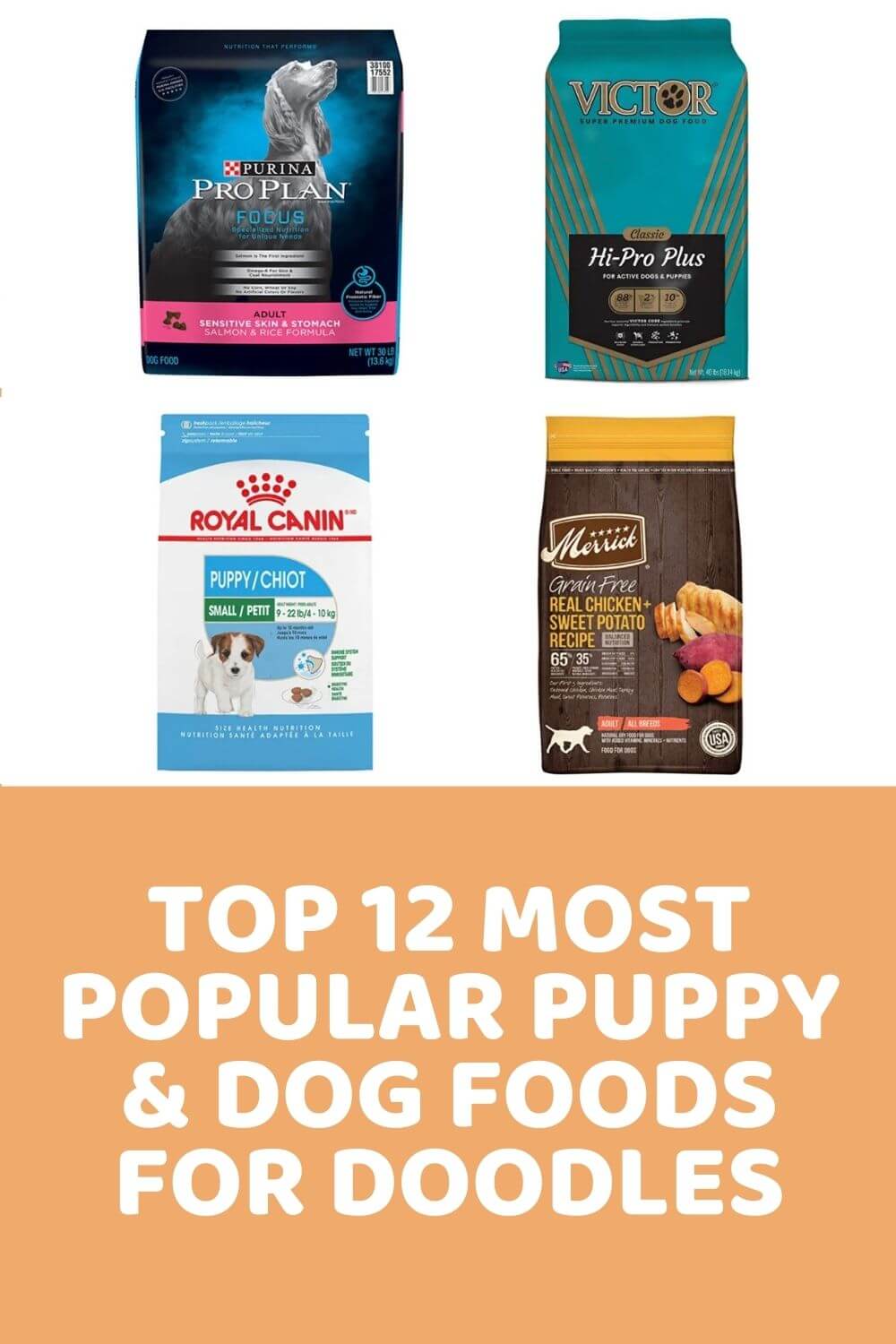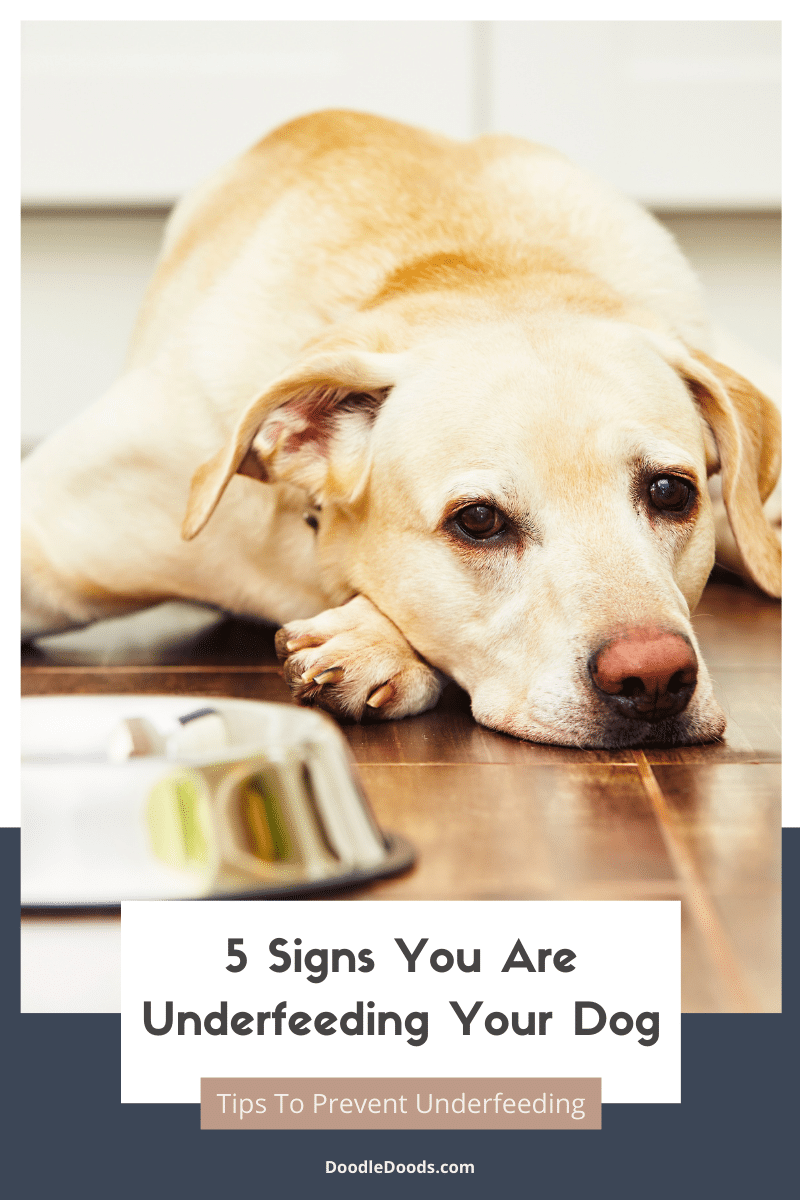You’re all set for Gotcha Day – you’ve got your dog beds and crates, toys and treats, food and water bowls, but what should you feed your new pup? In this guide, we’ll talk about how to choose the best 2-month-old puppy food for your new best pal so that you can nourish and spoil your new family member from the moment you bring them home. Let’s get started!
Table of Contents
- 2-Month Old Puppy Food Guide: Intro
- What Can I Feed My 2 Month Old Puppy?
- How Much Should I Feed A 2 Month Old Puppy?
- How Many Times Should I Feed My Puppy? Vet Recommended Puppy Feeding Schedule For Growth (Chart Included!)
- What Is The Best Time To Feed A Puppy?
- 2-Month Old Puppy Food: Top 5 High-Quality Dog Foods For 2 Months Old Puppy
- How Should I Bottle Feed My 2 Month Old Puppy?
- Things To Note While Feeding A Weaning Puppy
- Dry, Wet, Or Raw Food – Which One Is The Best For Puppies?
- Puppy Feeding Tips Every Dog Parent Must Know
- When Can My Puppy Switch To Adult Dog Food?
- 2-Month Old Puppy Food Guide: FAQs
- 2-Month Old Puppy Food Guide: Final Thoughts
2-Month Old Puppy Food Guide: Intro
Are you a proud new parent of a bundle of fluff that keeps you on your toes? Congratulations, because there’s nothing quite as exciting as welcoming a new furry friend into your family! But with your new role comes new responsibilities, especially when it comes to feeding your little one. As your little pup grows, so do their dietary needs, and it’s important to ensure they are getting the right nutrients for their age and size.
So, whether you’re a first-time dog owner or a seasoned pro, we’ve got you covered with our 2-month old puppy food guide – guaranteed to steer you in the right direction towards nourishing your tiny pooch the right way!
What Can I Feed My 2 Month Old Puppy?
So, what to feed a 2-month old puppy then? Feeding a two-month-old puppy can be a bit of a challenge, especially for new dog owners. After all, your new pup is still a baby – they were born just two months ago! And you want to make sure you’re doing everything right by your pal. Fortunately, there are some general guidelines that you can implement to ensure that you’re feeding your new puppy the right kind of food in correct quantities.
Choose The Right 2-Month Old Puppy Food
First and foremost, you’ll want to choose a high-quality puppy food that is specifically formulated to meet the nutritional needs of growing puppies. Look for protein-rich options made with real meat or fish, as well as whole grains and vegetables for added fiber. In addition to that, we recommend you avoid any subpar formulas that contain unnecessary filler ingredients, artificial flavors, or colorants. In fact, these ingredients can trigger allergies and lead to a host of other health issues.
For this reason, choosing the right 2-month old puppy food is crucial in preventing common health problems, including growth spurt stunting or obesity that can be caused by an improper diet.
A helpful trick is to continue feeding your new puppy the same food that they were given in the care of their breeder. Ethical breeders feed their puppies high-quality puppy food and they’ll be more than happy to share with you the exact brand and formula that they were feeding the pups. Many of them actually provide a small package for you to go on Gotcha Day!
Clean Drinking Water
Secondly, you should make sure to provide your puppy with access to clean drinking water at all times. Dehydration can easily occur at a young age, so be sure to keep their water bowl full and change it frequently.
Puppy Treats
Thirdly, we strongly advise against feeding your new pup any table scraps. Part of this is due to the fact that they’ll only keep wanting more this way! However, human foods can be harmful for our canine pals, especially if they’re heavily processed or contain a ton of salt, sugar, or other seasonings. To be fair, we should stay away from these types of foods as well, but no judgment here!
Instead, opt for puppy treats specifically designed for your puppy’s age and size. Nonetheless, your puppy’s treats shouldn’t make up any more than 10% of their daily caloric intake, so you might have to ignore those big and cute puppy eyes that are just begging for more. Here you’ll find some of our favorite puppy treats for puppies under 3 months.
How Much Should I Feed A 2 Month Old Puppy?
Feeding your 2-month-old puppy the right amount at each meal is crucial to their healthy development. However, the amount of food your puppy needs can vary based on their breed, weight, and activity level. In addition to that, not all puppy food formulas have the same caloric and macronutrient profile, so it’s important that you carefully read the label to figure out exactly how much your puppy needs.
That being said, most high-quality puppy foods will provide a feeding chart on their packaging that indicates how much you should feed your puppy based on their weight and age. Follow these guidelines, but don’t forget to take into account your puppy’s appetite and energy levels, as every dog is different.
As a general rule of thumb, your puppy’s daily caloric requirements are based on their estimated adult weight. Here’s a helpful puppy feeding chart to help you determine exactly how many calories you should feed your 2-month old puppy:
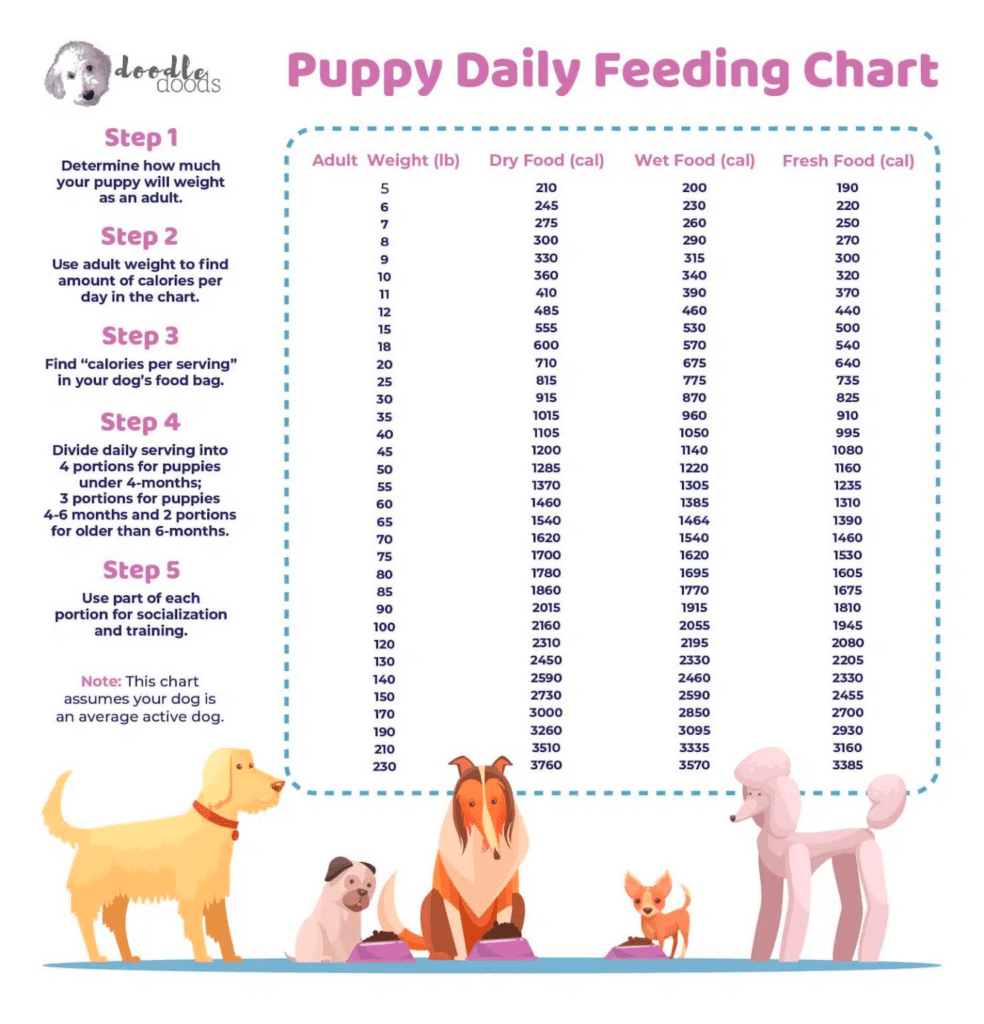
Remember, it’s important that you keep an eye on your puppy’s weight and overall development, and adjust their portions accordingly. And if you have any questions or concerns about your puppy’s diet, consult with your veterinarian – they can help you determine the right amount of food for your growing puppy as well as help you keep track of their development.
How Many Times Should I Feed My Puppy? Vet Recommended Puppy Feeding Schedule For Growth (Chart Included!)
At two months old, puppies should be fed about three to four smaller meals a day. This helps prevent overeating, aids in digestion, and provides your puppy with a steady source of energy throughout the day. What’s more, keeping your puppy on a daily schedule will also help with potty training, as you’ll know exactly when to take your pup out for potty.
Here’s a helpful puppy feeding chart by age that most pups can thrive on:
| Age | Frequency |
| 8-12 Weeks | 3-4 times a day |
| 4-5 Months | 3 times a day |
| 6-8 months | 2 times a day |
| 9-11 months | 2 times a day |
| 1-2+ years | 2 times a day |
What Is The Best Time To Feed A Puppy?
A helpful tip for feeding your two month old puppy is to schedule their meal times around your own breakfast, lunch, snack, and dinner. This is a great time for your pup to socialize with the whole family. Additionally, this will help you keep track of your puppy’s schedule more easily, too.
PS! We recommend you don’t feed your puppy their last meal immediately before bedtime. Rather, make it a few hours before so that your pup has enough time to digest and go potty a few times before their beauty sleep.
2-Month Old Puppy Food: Top 5 High-Quality Dog Foods For 2 Months Old Puppy
ORIJEN Puppy Grain-Free Dry Puppy Food
This ORIJEN puppy formula is one of our top picks for young puppies, as it’s packed with protein and fat that come from premium animal ingredients. It contains a whopping 85% of animal ingredients with the first five ingredients listed as animal proteins.
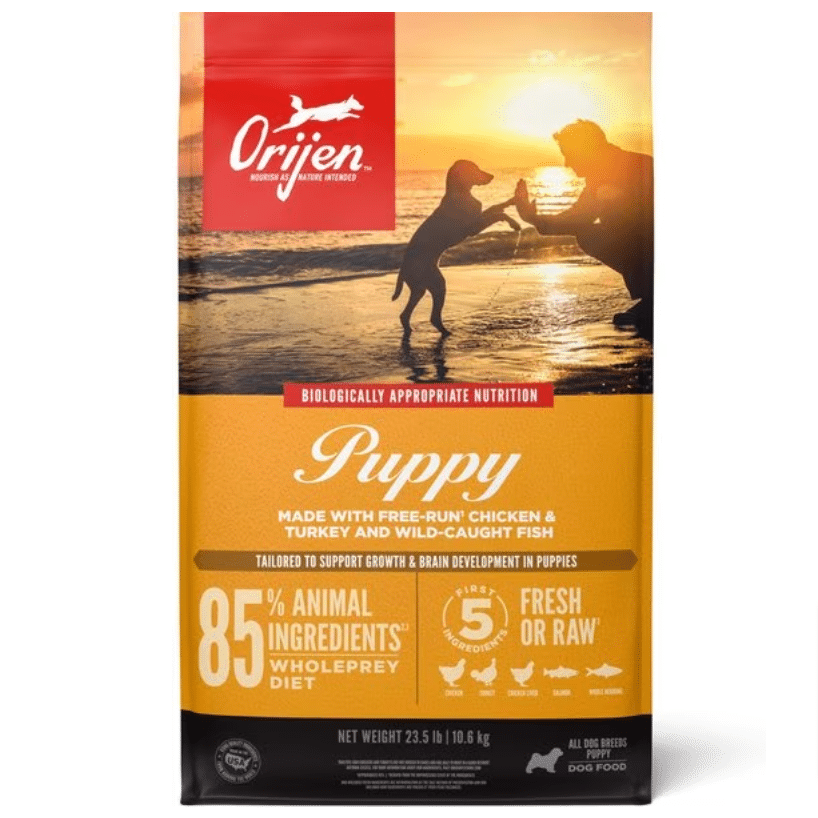
This formula includes chicken and turkey, turkey giblets and chicken liver, flounder, whole mackerel, and whole herring. It also includes a ton of other highly nutritious, real ingredients like lentils, pinto beans, peas, pumpkin, collard greens, apples, and much more. What’s more, it’s also fortified with probiotics to keep your pup’s tummy healthy and happy.
Purina Pro Plan Sport Puppy High Protein Chicken & Rice Wet Dog Food
If you’re looking for a 2-month old puppy food that comes in wet formula, then you can’t go wrong with this Purina Pro Plan Chicken & Rice Formula that’s specially made for active pups. The number one ingredient listed is real chicken and it also features omega-3 fatty acids for that extra health boost. It also contains a blend of 23 essential vitamins and minerals to support your growing puppy. And if your pup isn’t a fan of chicken, you can also opt for the same formula with beef instead!
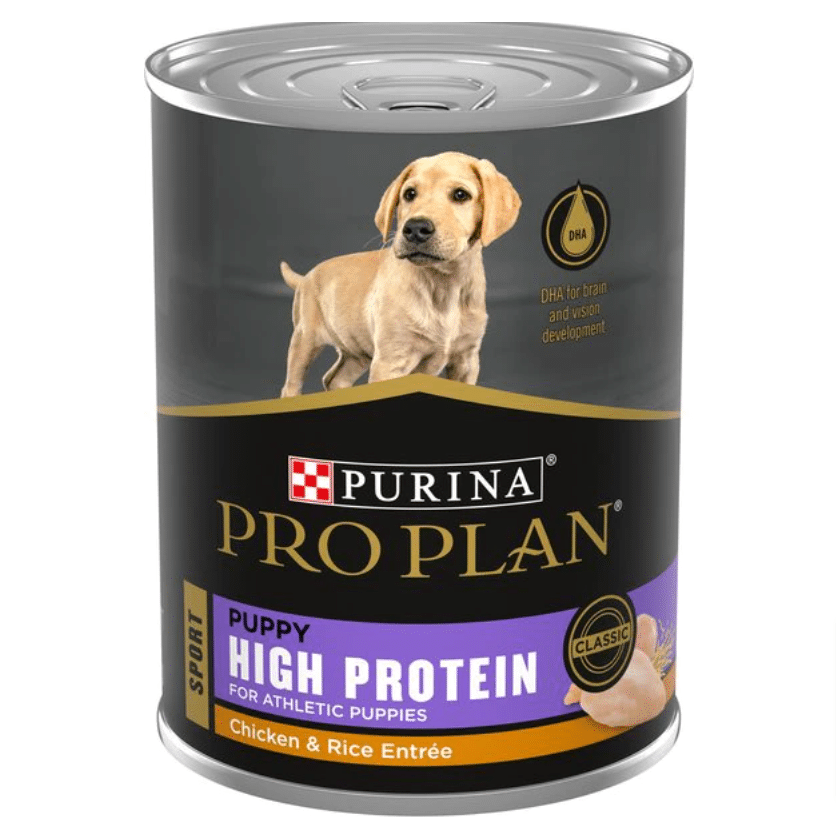
Wellness CORE Grain-Free Puppy Chicken & Turkey Recipe Dry Dog Food
If you’re looking for a grain-free 2-month old puppy food, then be sure to check out this Wellness CORE dry kibble. This one’s perfect for small pups as the small kibble size makes it easy to devour.
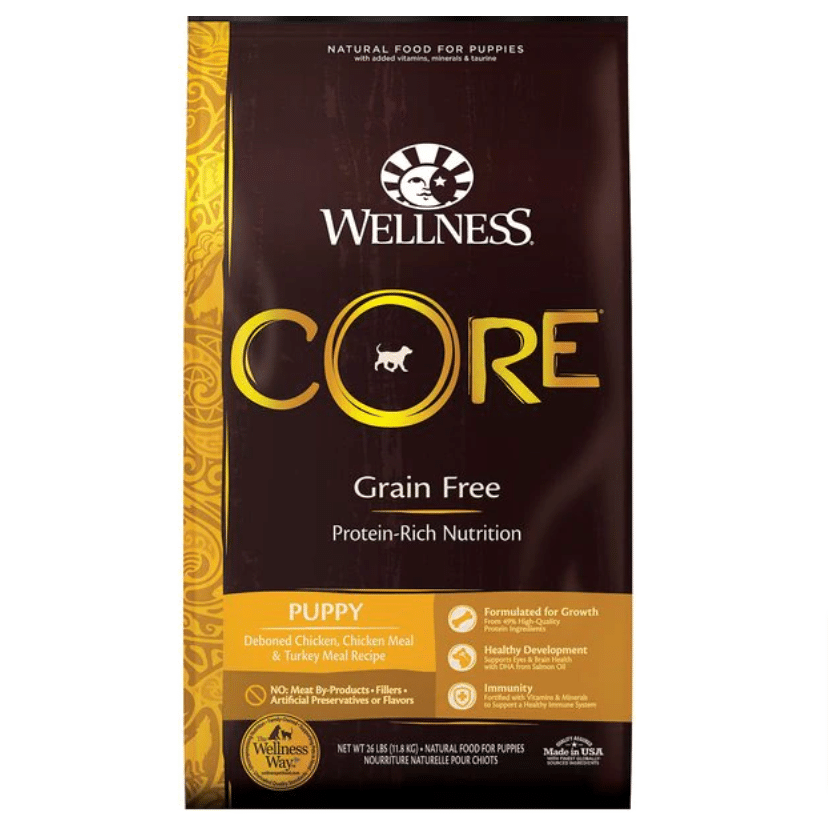
It’s formulated with chicken, turkey, salmon oil, fruits, and veggies – all of which your lil’ pup needs to grow into a healthy and strong adult. You’ll also find healthful ingredients like glucosamine, taurine, omega fatty acids, probiotics, and numerous vitamins and minerals in this excellent puppy kibble.
By the way, this formula doesn’t contain any meat by-products, fillers, frain, corn, soy, wheat gluten, or artificial preservatives, flavors, or colors.
Diamond Naturals Chicken Dinner Adult & Puppy Canned Dog Food
Another wet 2-month old puppy food we have on this list is by Diamond Naturals. It’s made with high-quality chicken that’s sure to nourish your active pup with its high protein content. It also contains a ton of veggies and superfoods that are packed with nutrients, as well as added vitamins and minerals that are needed for growing puppies.
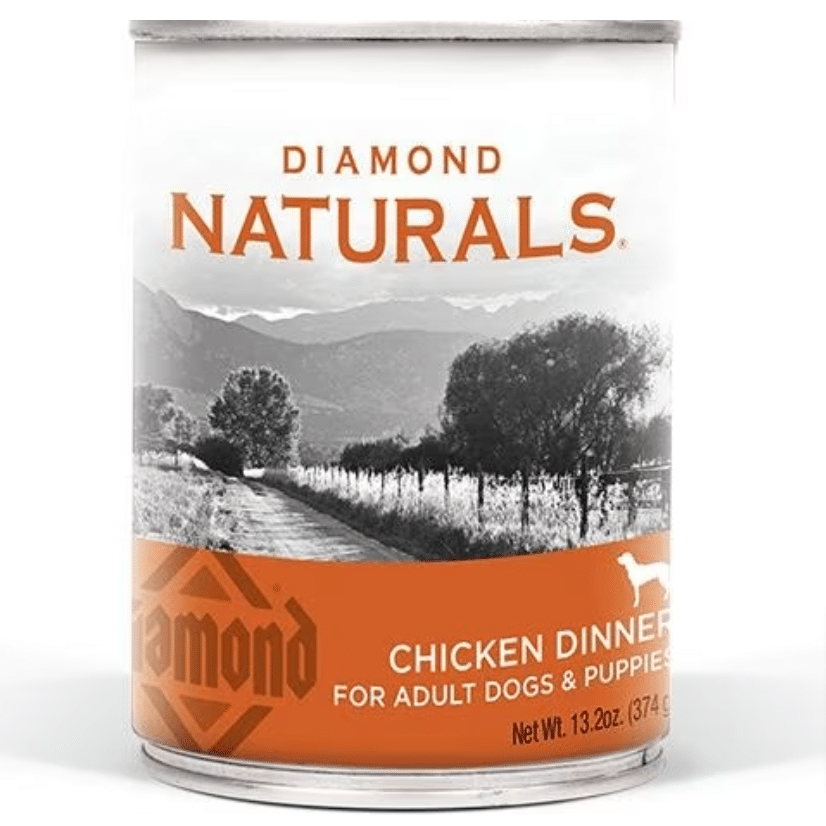
Whether your new pup prefers a wet food diet or you’d just like to give them a little something extra to top up their usual dry kibble, this canned food is the perfect choice. It contains only sustainably-sourced ingredients and there’s zero wheat, corn, fillers, or artificial flavors, colors, or preservatives in the formula.
Royal Canin Breed Health Nutrition German Shepherd Puppy Dry Dog Food
If you’re a proud parent of a purebred German Shepherd or a Shepadoodle (German Shepherd-Poodle mix), then it’s worth checking out this Royal Canin dry kibble specially formulated for German Shepherds. It has a special kibble shape that’s designed for German Shepherd’s long and strong muzzle, making it easier for your pup to chew their food properly.
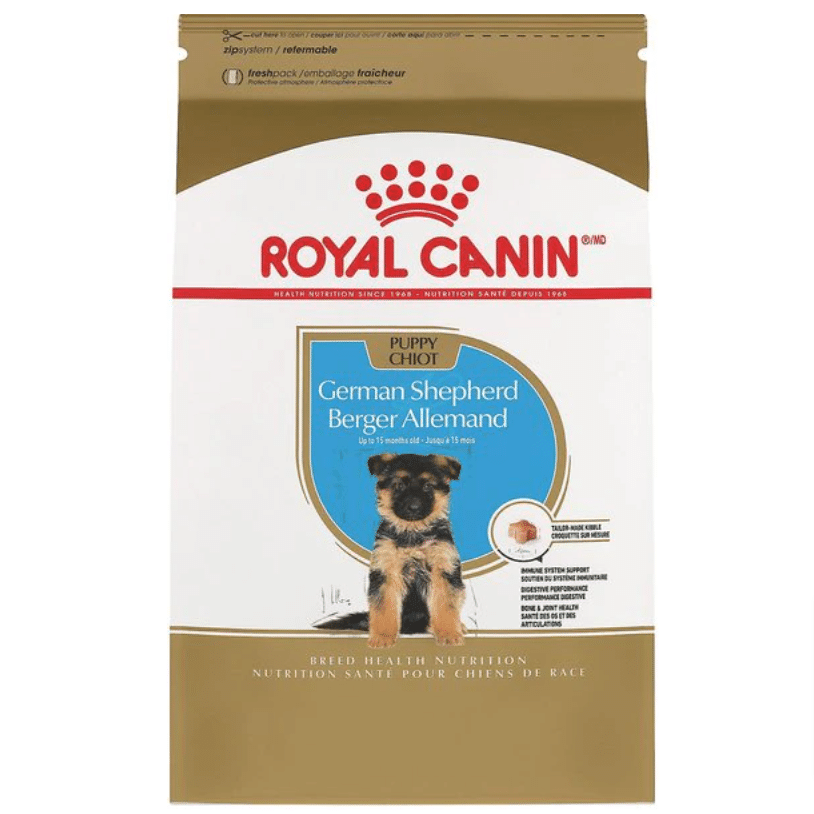
This wonderful puppy kibble is designed for large-sized pups that need highly digestible proteins and specific fibers in their diets. It also contains ingredients like glucosamine and chondroitin that work in synergy to promote good joint and bone health. There’s also an added mix of antioxidants and vitamins that support your puppy’s growth, development, and immune system.
How Should I Bottle Feed My 2 Month Old Puppy?
Bottle feeding isn’t necessary for 2-month old puppies, as by this time they should be fully weaned either from mother’s milk or from bottle feeding. However, in some instances it might still be necessary – either due to a health concern or if your puppy hasn’t been weaned at a proper time.
That being said, bottle feeding a 2-month-old puppy can be a bit of a challenge, but with the right technique and tools, you’ll be able to give your puppy the nourishment they need to grow healthy and strong. Here’s a quick guide on how to bottle feed your 2-month-old puppy:
Select The Right Formula
It’s vital that you choose an appropriate puppy formula that is recommended by your veterinarian. Don’t feed your puppy cow’s milk as it’s difficult for them to digest and it doesn’t contain the essential nutrients they need for proper development.
Choose The Right Bottle
Choose a small, soft, and flexible bottle for your puppy. Soft bottles are ideal as they closely mimic the natural feel of a mother’s nipple, which will make it easier for your puppy to ‘nurse’.
Warm The Formula
Puppies prefer their formula to be warm. Place the bottle in a bowl of warm water for a few minutes, or you can use a warm milk replacer. Check the temperature of the formula by dripping some of it on the inside of your wrist – it should feel warm to the touch, but not hot. You don’t want to accidentally burn your delicate pup!
Hold Your Puppy Properly
When holding your puppy during feeding, make sure they are in a comfortable position. Place your puppy on their stomach with their head on your hand and their hind legs behind you. When feeding, hold the bottle at a slight angle to prevent too much air from filling your puppy’s stomach.
Follow The Feeding Schedule
Regardless if your puppy is already on solid food or still being bottle fed, you should keep them on a set feeding schedule. If your vet requires your 2-month old puppy to be bottle fed, make sure you follow their exact feeding guidelines in terms of timing.
Clean The Bottle
After feeding your puppy, clean the bottle and nipple using hot soapy water and a bottle brush. Rinse thoroughly with clean water.
Things To Note While Feeding A Weaning Puppy
Weaning is the process of introducing solid foods to a puppy and reducing their dependency on their mother’s milk. Typically, this is done around the time puppies are 3 to 4 weeks of age. Here are some things to keep in mind while feeding a weaning puppy:
Gradual Introduction
It’s important to introduce solid foods gradually to your puppy over a few weeks. Start by mixing a small amount of puppy food with warm water or puppy milk replacer, gradually increasing the amount of solid food while decreasing the liquid.
Quality Food
Choose high-quality puppy food that is specifically formulated for your puppy’s age, size, and breed. Avoid feeding your puppy table scraps and human food, as this can upset their stomach and lead to nutritional imbalances. Not to mention, this will only teach your pup bad table manners.
Small Portions
Feed your puppy small portions throughout the day to encourage healthy digestion. At four to eight weeks old, your puppy will need to be fed 3 to 4 small meals a day.
Water
Always have fresh water available for your puppy. This is especially important when they start eating solid foods, as they can become easily dehydrated.
Monitor Your Puppy
Monitor your puppy’s eating patterns and weight gain to ensure they are receiving the proper nourishment. Consult with your veterinarian if you have any concerns about their diet or growth.
Avoid Overfeeding
Puppies have small stomachs, so it’s important to avoid overfeeding. Follow the feeding instructions on your puppy food package, but also pay attention to your puppy’s appetite and energy levels.
Dry, Wet, Or Raw Food – Which One Is The Best For Puppies?
Choosing a type of food for your puppy can be overwhelming, as there are many different options available. Here’s a breakdown of each type of puppy food and their pros and cons:
Dry Food
Dry food, also known as kibble, is the most common type of food for puppies at 2 months old. It is convenient to store and serve, has a long shelf life, and can promote good dental health by helping to remove plaque and tartar. However, some puppies may find dry food difficult to digest, especially if it contains a lot of grains. If at 2 months old puppy food doesn’t seem to go down as easily, you can try soaking it in warm water at first until your pup gets used to it.
Wet Food
Wet food is made up of a high percentage of water and can be easier for some puppies to digest. It is also more flavorful and has a better smell, which can be appealing to picky eaters. However, it can be more expensive and it has a shorter shelf life than dry food.
Raw Food
Raw food is a diet that consists of uncooked meat, fruits, and vegetables. Supporters of raw food diets argue that it can improve skin and coat health, reduce allergies, and promote healthy digestion. However, it can be expensive, time-consuming to prepare, and there is a risk of bacteria and disease if not handled, prepared, and stored correctly.
Moreover, it can be difficult to ensure that homemade food for a 2-month old puppy contains all the essential nutrients in balanced ratios. Since puppies are rather delicate and still developing their immune systems, feeding them raw food could pose some serious risks.
Puppy Feeding Tips Every Dog Parent Must Know
Consistency is Key
Feed your puppy consistently! Feeding your puppy at the same time every day and the same amount encourages a healthy digestive system. And as we mentioned earlier, this will also help with potty training.
Portion Size
Portion size is important as you do not want to overfeed or underfeed your puppy. Follow the feeding guidelines on the back of your puppy food package and take note of the puppy feeding chart above.
In addition to that, you should also keep track of your puppy’s weight and growth each week. This way, you’ll notice any abnormalities early on that could indicate a potential health issue or an improper diet.
Never Free Feed Your Puppy
We advise against free feeding your 2-month old puppy, as this could lead to either nutritional deficiencies or obesity. Both of which can negatively affect your puppy’s health and development. Free feeding can also work against your puppy’s table manners, so that’s something to keep in mind as well!
Keep The Food Bowl Clean And Bacteria-Free
We recommend you opt for either stainless steel or glass food and water bowls, as these are more hygienic than plastic bowls. Make sure to keep the feeding area clean and wash the bowls daily to prevent any harmful bacteria.
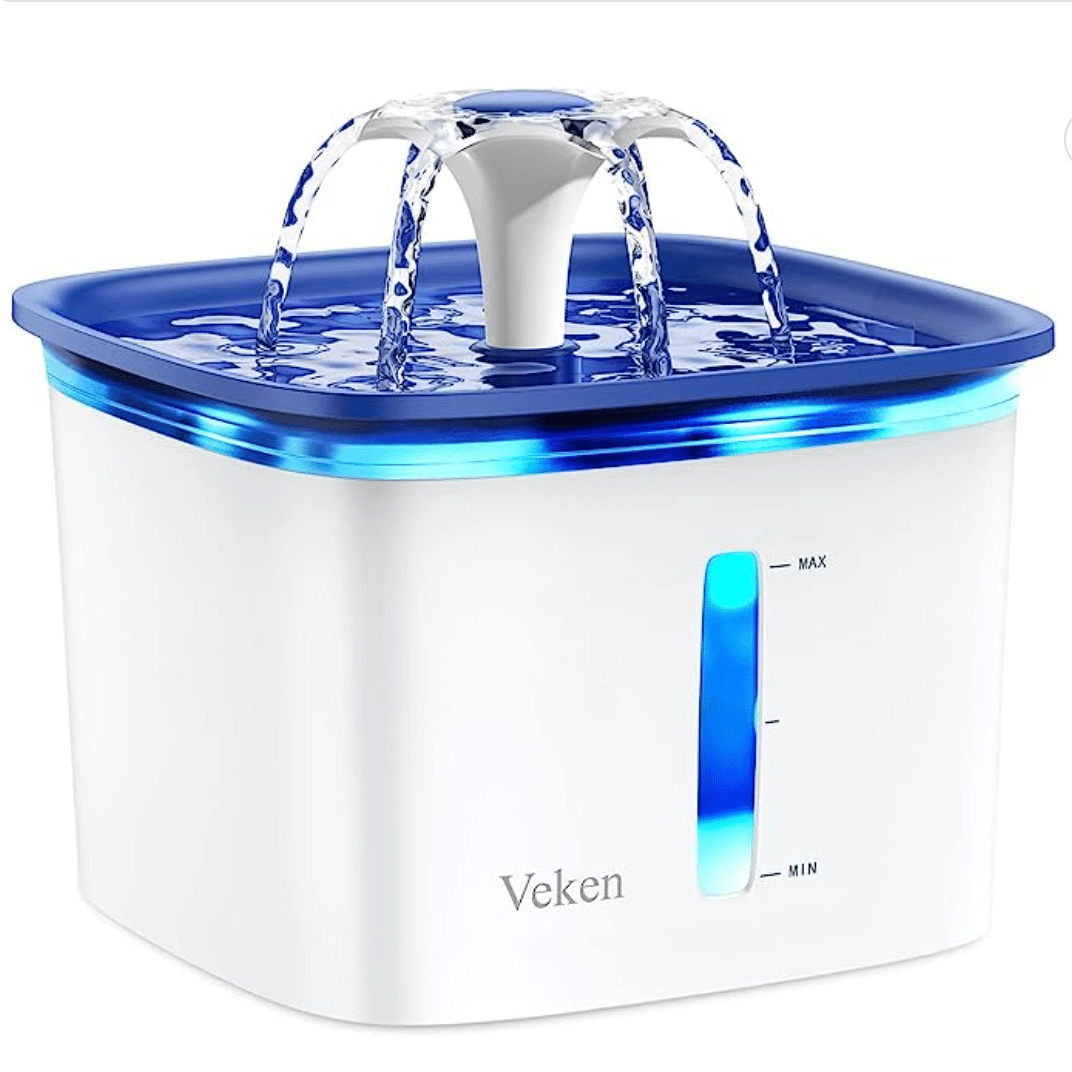

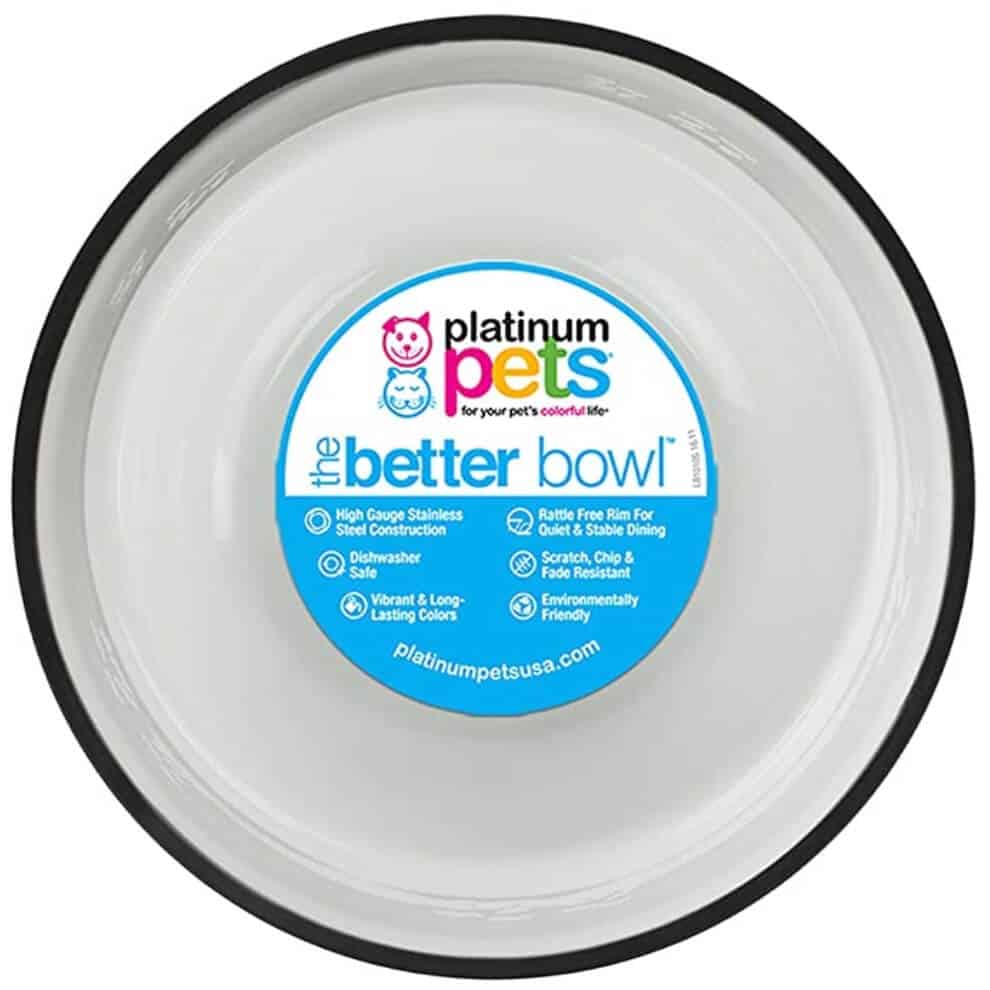
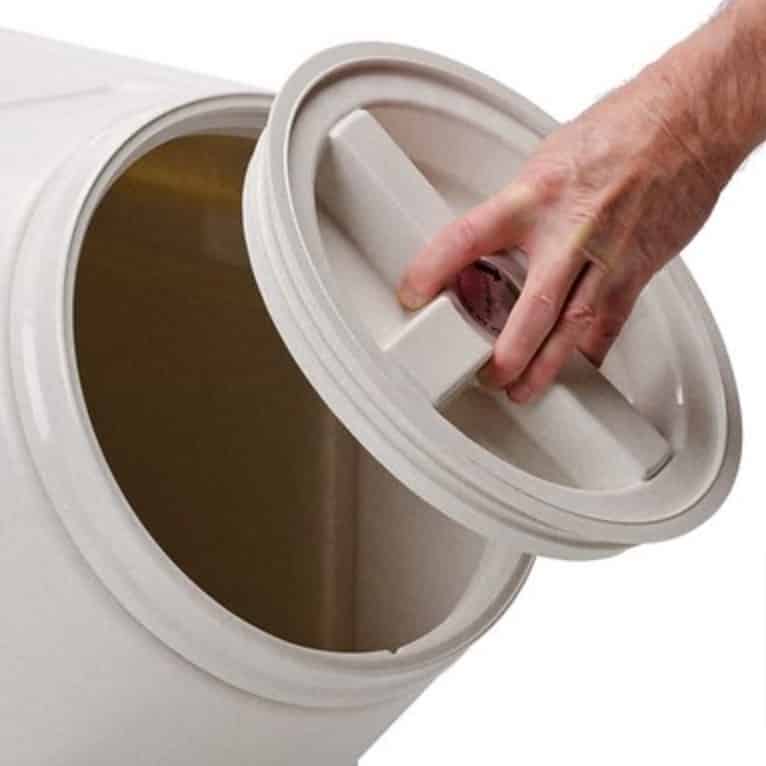
Don’t Change The Feeding Spot And Stick To A Feeding Schedule
We cannot stress enough how important it is to stick to a set schedule day in and day out. Not only should you feed your 2-month old puppy food at the same time each day, you should also feed them at the same feeding spot so that they develop a sense of safety and security. This way, your new puppy will soon learn their daily schedule and expect the usual meals and potty breaks!
Use Slow Feeders If Necessary
Some pups just love to devour their food in one breath, but it might not be the best way to go. Using a slow feeder can be very helpful if your puppy tends to eat their food a bit too quickly, such as these recommended here.
When Can My Puppy Switch To Adult Dog Food?
Puppies have different dietary needs than adult dogs, so it’s essential to select 2-month-old puppy food that meets all your puppy’s nutritional requirements.
Puppies can usually switch to an adult dog food formula once they start nearing their full adult size. However, this can significantly vary from dog to dog, as some pups grow up faster than others. Generally, smaller dogs reach their full size much earlier than larger dogs.
Therefore, it’s important to keep in mind that every dog is different, and your puppy’s growth and development can vary based on their breed, activity level, and overall health. Consult with your vet to determine the best time to switch your puppy to an adult dog food formula.
2-Month Old Puppy Food Guide: FAQs
No, 2-month old puppies don’t need milk, as they should already be weaned off of their mother’s milk and transitioning to solid food.
While small amounts of plain yogurt or curd can be safe for some puppies, it’s important to introduce it gradually and in moderation. Dogs have difficulty digesting lactose, so feeding them large amounts of dairy products like curd can cause an upset stomach and diarrhea. Additionally, some dogs may be lactose intolerant and should not consume dairy at all. It’s best to consult with your veterinarian before giving your puppy any new foods to ensure that they are safe and appropriate for their individual needs.
At 2 months old, a puppy can begin to tolerate small amounts of rice in their diet. Yet again, you’ll want to introduce it to their diet gradually. Interestingly, many dog foods for 2-month old puppies actually contain rice, as it’s a good source of healthy carbs that they need from their diets.
While homemade dog food can be a healthy alternative for some puppies, it’s important to ensure that their diet is nutritionally balanced and their caloric needs are met. For this reason, we wouldn’t exactly recommend feeding homemade dog food for puppies at 2 months old unless it’s recommended by your vet. The AKC has a great article on this topic with a homemade dog food recipe included.
Yes, dry dog food for a 2-month old puppy is one of the most popular choices. Nonetheless, you should only opt for a high-quality puppy food that’s specially formulated for puppies, taking into account their special needs during this delicate life stage.
2-Month Old Puppy Food Guide: Final Thoughts
Feeding your new puppy can be challenging at first, but choosing the right 2-month-old puppy food will make all the difference. By following these guidelines we mentioned, you’ll ensure that your puppy is getting the proper nutrition they need to grow up healthy and strong. And remember to consult with a veterinarian if you have any concerns about your puppy’s diet, growth, or health in general.
Learn How to Care for Your Doodle Puppy!

Perfect for first-time Doodle parents, get ALL your questions answered, including questions new Doodle parents don’t even think to ask.
Plus, get $700 worth of Bonus Materials for FREE, including:- Doodle Parenthood Community and Support Group ($190 value)
- Doodle Puppy Growth Tracker ($20 value)
- EMERGENCY Cheatsheet: When To Call The Vet Immediately ($50 value)
- HELP! Button ($145 value)
- And SO MUCH MORE!
The information on this page is for informational purposes only. It is not intended to be a substitute for qualified professional veterinary advice, diagnosis, or treatment. Always seek the advice of your veterinarian or other qualified animal health provider with any questions you may have.



